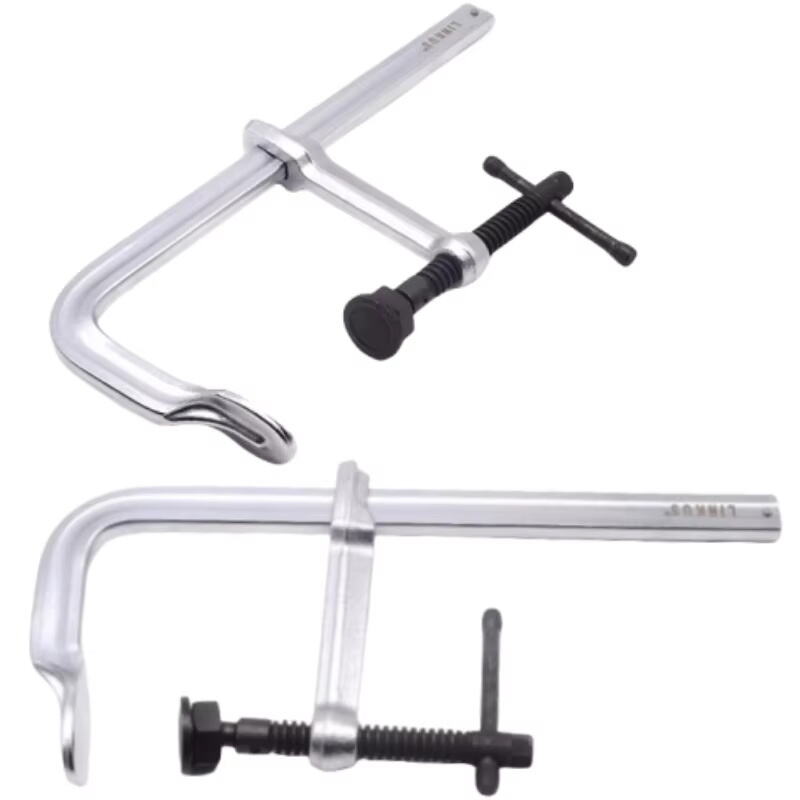اختيار الحجم والمواد المثالية لمشابك F الثقيلة
ثقيل التحمل مكابس F هي أدوات أساسية تُستخدم في أعمال النجارة، وتشكيل المعادن، والمهام الصناعية التجميعية. يمكن أن يؤثر اختيار الحجم والمواد المناسبة تأثيرًا كبيرًا على كفاءة المشروع، ومتانته، وسلامته العامة. ويضمن الاختيار الصحيح تثبيت القطع المراد العمل عليها بشكل آمن، ويقلل من خطر الانزلاق، ويعزز دقة العمليات. وتتخصص شركات مثل Wuxi Lingdao Automation Technology في إنتاج إكسسوارات عالية الجودة أجهزة الأثاث بما في ذلك مشابك F المتينة، مع الاعتماد على خطوط إنتاج متقدمة وأنظمة صارمة لمراقبة الجودة لضمان الثبات والموثوقية.
فهم أحجام المشابك
أهمية طول المشبك الصحيح
طول المشبك مكبس ف يحدد الحد الأقصى لسعة الفتح وعمق المادة التي يمكنه احتجازها. قد يؤدي اختيار مشبك قصير جدًا إلى تقييد قدرتك على تثبيت القطع الكبيرة، في حين يمكن أن يكون المشبك الطويل جدًا غير عملي ويصعب التحكم فيه. يضمن اختيار الطول المناسب الاستقرار والرافعة المناسبة أثناء عمليات التثبيت.
ملاحظات حول عمق الفك وحجم الحنجرة
يؤثر عمق حنجرة مشبك F على مدى عمق وصول المشبك إلى داخل القطعة العاملة. تتيح الحناجر الأعمق الوصول إلى مركز الألواح العريضة أو الألواح المعدنية. إن فهم أبعاد مشاريعك النموذجية واختيار مشبك بعمق حنجرة كافٍ يعزز المرونة والكفاءة. ويمنع القياس الصحيح الإجهاد الزائد على المشبك ويحافظ على ضغط متساوٍ عبر القطعة العاملة.
اختيار المادة المناسبة
مشابك فولاذية للقوة والمتانة
تُعدّ مشابك الفولاذ على شكل F متينة للغاية وقادرة على تحمل ضغوط كبيرة دون الانحناء أو التشوه. مما يجعلها مثالية للمشاريع الشاقة في مجالات النجارة والحدادة. تُحافظ مشابك الفولاذ على قوة ضغط ثابتة مع مرور الوقت، كما أنها مقاومة للتآكل، مما يضمن موثوقية طويلة الأمد. توفر مشابك الفولاذ عالية الجودة، التي تنتجها شركات موثوقة مثل Wuxi Lingdao Automation Technology، أداءً ممتازًا للتطبيقات الاحترافية والصناعية.
مشابك الألومنيوم للتطبيقات خفيفة الوزن
تقدم مشابك الألومنيوم على شكل F ميزة التخفيض في الوزن مع الحفاظ على قوة معقولة. تكون هذه المشابك أسهل في المناورة، خاصة أثناء المهام الطويلة أو عند الاستخدام في الأماكن المرتفعة. وعلى الرغم من أن الألومنيوم قد لا يوفر نفس مستوى قوة الضغط مثل الفولاذ، فإنه مناسب للمشاريع الخفيفة حيث تكون الأولوية للقدرة على الحمل والحركة. وغالبًا ما تكون مشابك الألومنيوم مزودة بطبقات مقاومة للتآكل، مما يعزز متانتها.
تقييم قوة التثبيت والآلية
آليات المسمار والمشبك
تؤثر آلية المشبك على شكل حرف F في سهولة الاستخدام وقوة التثبيت القابلة للتحقيق. تتيح مشابك الحامل ذات النوع اللولبي تعديلات دقيقة للضغط وهي مثالية للأعمال الدقيقة التي تتطلب قوة مضبوطة. أما المشابك ذات الأنواع السريعة فتوفر تشغيلًا أسرع وتعديلات فورية، مما يمكن أن يوفر الوقت في المهام المتكررة. ويُعتمد اختيار الآلية المناسبة على المتطلبات الخاصة بمشاريعك.
ضمان توزيع متساوٍ للضغط
يُعد توزيع الضغط بالتساوي أمرًا بالغ الأهمية لمنع تلف القطع العاملة وضمان اتصالات قوية. تدمج المشابك عالية الجودة فكوكًا مُصلبة وأسطح تثبيت مسطحة للحفاظ على تماس موحد. ويقلل التصميم المناسب للفكوك من خطر خدش الأسطح، واختيار مشابك ذات أذرع أو قضبان معززة يضمن تثبيتًا مستقرًا تحت ضغط عالٍ. ويعزز هذا الاهتمام بالتصميم كلًا من السلامة وجودة المشروع.

اعتبارات المتانة والصيانة والتكلفة
عمر طويل لمشابك F عالية الجودة
تمتد حياة مشابك F الثقيلة بفضل المواد المتينة وعمليات التصنيع الدقيقة. يمكن لنماذج الفولاذ والألومنيوم المقوى أن تتحمل الاستخدام المتكرر على مدى سنوات عديدة دون تدهور كبير. إن الاستثمار في مشابك عالية الجودة من شركات موثوقة مثل Wuxi Lingdao Automation Technology يضمن الحفاظ على أداء الأدوات، مما يقلل الحاجة إلى الاستبدال المتكرر.
نصائح الصيانة لتحقيق الأداء الأمثل
إن التنظيف المنتظم وتزييت خيوط البرغي وفحص أسطح التثبيت يمنعان الصدأ ويقللان الاحتكاك ويحافظان على التشغيل السلس. كما أن تخزين المشابك بشكل صحيح في بيئات جافة يمنع التآكل ويطيل عمرها الافتراضي. ويساعد الصيانة الجيدة أيضًا في الحفاظ على ضغط التثبيت الدقيق، وهو أمر ضروري للعمل بدقة ولإطالة عمر المشابك وأجزاء العمل على حد سواء.
العمل مع مورد موثوق
حلول الأجهزة الشاملة
تقدم شركة Wuxi Lingdao Automation Technology مجموعة كاملة من إكسسوارات الأجهزة، بما في ذلك مشابك F عالية الجودة، وقضبان انزلاقية ذات كريات تحمل مفصلات وأقواس الخزانات. إن التزامهم بالتخصيص حسب الطلب (OEM) يضمن للعملاء الحصول على حلول الأجهزة المعدنية المصممة وفقًا للاحتياجات المحددة ومتطلبات المشروع.
الالتزام بالجودة ورضا العملاء
مع خطوط إنتاج أوتوماتيكية متقدمة وضوابط صارمة للجودة، تضمن شركة ووشى لينغداو الاستقرار والموثوقية في كل منتج. ودمجها للعمليات التقليدية مع التكنولوجيا الحديثة يكفل أن تفي مكابس F والمكونات المعدنية الأخرى بالمعايير الاحترافية. ويتيح التعاون مع مورد موثوق الوصول إلى منتجات موثوقة ودعم فني وراحة بال.
الأسئلة الشائعة
كيف أختار مقاس مكبس F المناسب لمشاريعي
خذ بعين الاعتبار سعة الفتح القصوى، وعمق الفك، والأبعاد النموذجية لقطع العمل. إن مطابقة مقاس المكبس مع المواد المستخدمة يضمن تثبيتًا آمنًا ويمنع الإجهاد أو الانزلاق أثناء العمليات.
ما هو أفضل مادة للتثبيت الثقيل
يُعد الفولاذ مثاليًا للتطبيقات الشاقة بسبب قوته ومتانته. ويُقدم الألومنيوم خفة في الوزن وسهولة في الحمل للمهام متوسطة الشدة. ويعتمد الاختيار على قوة التثبيت المطلوبة ونطاق المشروع.
كيف يمكنني صيانة مشابك F للاستخدام الطويل الأمد؟
إن التنظيف المنتظم، وتزييت خيوط المسمار، وفحص الفكين يمنعان التآكل والتلف. كما أن التخزين السليم في بيئات جافة يساعد على الحفاظ على الأداء ويضمن ضغط تثبيت متسق.
لماذا تختار مصنعًا احترافيًا لمشابك F؟
إن العمل مع شركة ذات سمعة طيبة مثل Wuxi Lingdao Automation Technology يضمن لك الوصول إلى مشابك عالية الجودة ومتينة، ودعمًا فنيًا موثوقًا، ومنتجات مصممة خصيصًا لتلبية احتياجات المشاريع المحددة، مما يعزز الكفاءة والسلامة.

